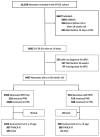Systemic Steroids in Preventing Bronchopulmonary Dysplasia (BPD): Neurodevelopmental Outcome According to the Risk of BPD in the EPICE Cohort
- PMID: 35564997
- PMCID: PMC9106050
- DOI: 10.3390/ijerph19095600
Systemic Steroids in Preventing Bronchopulmonary Dysplasia (BPD): Neurodevelopmental Outcome According to the Risk of BPD in the EPICE Cohort
Abstract
Background: Postnatal steroids (PNS) have been used to prevent bronchopulmonary dysplasia (BPD) in preterm infants but have potential adverse effects on neurodevelopment. These effects might be modulated by their risk of BPD. We aimed to compare patients' neurodevelopment with PNS treatment according to their risk of BPD in a European cohort.
Methods: We developed a prediction model for BPD to classify infants born between 24 + 0 and 29 + 6 weeks of gestation in three groups and compared patients' neurological outcome at two years of corrected age using the propensity score (PS) method.
Results: Of 3662 neonates included in the analysis, 901 (24.6%) were diagnosed with BPD. Our prediction model for BPD had an area under the ROC curve of 0.82. In the group with the highest risk of developing BPD, PNS were associated with an increased risk of gross motor impairment: OR of 1.95 after IPTW adjustment (95% CI 1.18 to 3.24, p = 0.010). This difference existed regardless of the type of steroid used. However, there was an increased risk of cognitive anomalies for patients treated with dexa/betamethasone that was no longer observed with hydrocortisone.
Conclusions: This study suggests that PNS might be associated with an increased risk of gross motor impairment regardless of the group risk for BPD. Further randomised controlled trials exploring the use of PNS to prevent BPD should include a risk-based evaluation of neurodevelopmental outcomes. This observation still needs to be confirmed in a randomised controlled trial.
Keywords: bronchopulmonary dysplasia; neurodevelopmental outcome; post natal steroid therapy; preterm birth.
Conflict of interest statement
The authors declare no conflict of interest.
Figures



Similar articles
-
Inhalation or instillation of steroids for the prevention of bronchopulmonary dysplasia.Neonatology. 2015;107(4):358-9. doi: 10.1159/000381132. Epub 2015 Jun 5. Neonatology. 2015. PMID: 26044104 Review.
-
Systemic Hydrocortisone To Prevent Bronchopulmonary Dysplasia in preterm infants (the SToP-BPD study); a multicenter randomized placebo controlled trial.BMC Pediatr. 2011 Nov 9;11:102. doi: 10.1186/1471-2431-11-102. BMC Pediatr. 2011. PMID: 22070744 Free PMC article. Clinical Trial.
-
Efficacy and safety of systemic hydrocortisone for the prevention of bronchopulmonary dysplasia in preterm infants: a systematic review and meta-analysis.Eur J Pediatr. 2019 Aug;178(8):1171-1184. doi: 10.1007/s00431-019-03398-5. Epub 2019 May 29. Eur J Pediatr. 2019. PMID: 31144162 Free PMC article.
-
Systemic Hydrocortisone To Prevent Bronchopulmonary Dysplasia in preterm infants (the SToP-BPD study): statistical analysis plan.Trials. 2018 Mar 9;19(1):178. doi: 10.1186/s13063-018-2505-y. Trials. 2018. PMID: 29523175 Free PMC article. Clinical Trial.
-
[The use of postnatal corticosteroid therapy in premature infants to prevent or treat bronchopulmonary dysplasia: current situation and recommendations].Arch Pediatr. 2010 Oct;17(10):1480-7. doi: 10.1016/j.arcped.2010.07.013. Epub 2010 Sep 22. Arch Pediatr. 2010. PMID: 20864322 French.
Cited by
-
Inhaled and Systemic Steroids for Bronchopulmonary Dysplasia: Targeting Inflammation and Oxidative Stress.Antioxidants (Basel). 2025 Jul 16;14(7):869. doi: 10.3390/antiox14070869. Antioxidants (Basel). 2025. PMID: 40722975 Free PMC article. Review.
-
Perinatal Treatment with Corticosteroids and Its Relation with Neurodevelopment in Premature Newborns: A Systematic Review of the Literature.Turk Arch Pediatr. 2025 Jul 1;60(4):355-361. doi: 10.5152/TurkArchPediatr.2025.24299. Turk Arch Pediatr. 2025. PMID: 40637325 Free PMC article.
-
Systemic Postnatal Corticosteroids, Bronchopulmonary Dysplasia, and Survival Free of Cerebral Palsy.JAMA Pediatr. 2025 Jan 1;179(1):65-72. doi: 10.1001/jamapediatrics.2024.4575. JAMA Pediatr. 2025. PMID: 39556404
-
An updated review on systemic glucocorticoids in the prevention and treatment of bronchopulmonary dysplasia.Pediatr Discov. 2023 Jun 12;1(1):e6. doi: 10.1002/pdi3.6. eCollection 2023 Jun. Pediatr Discov. 2023. PMID: 40625572 Free PMC article. Review.
-
Efficacy and tolerance of intravenous methylprednisolone pulses in children with severe bronchopulmonary dysplasia requiring respiratory support.Pediatr Pulmonol. 2025 Jan;60(1):e27344. doi: 10.1002/ppul.27344. Epub 2024 Oct 22. Pediatr Pulmonol. 2025. PMID: 39436116 Free PMC article.
References
-
- Short E.J., Kirchner H.L., Asaad G.R., Fulton S.E., Lewis B.A., Klein N., Eisengart S., Baley J., Kercsmar C., Min M.O., et al. Developmental sequelae in preterm infants having a diagnosis of bronchopulmonary dysplasia: Analysis using a severity-based classification system. Arch. Pediatr. Adolesc. Med. 2007;161:1082–1087. doi: 10.1001/archpedi.161.11.1082. - DOI - PMC - PubMed
Publication types
MeSH terms
Substances
LinkOut - more resources
Full Text Sources

